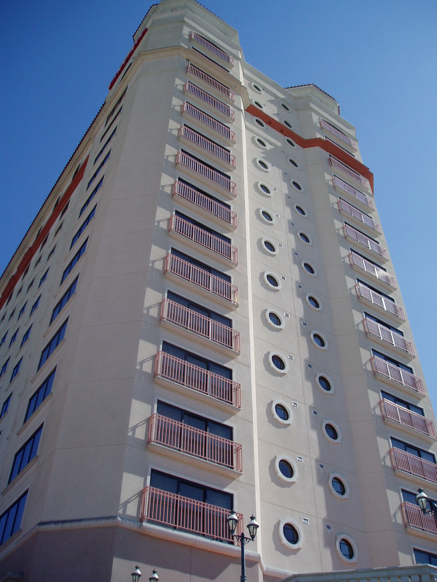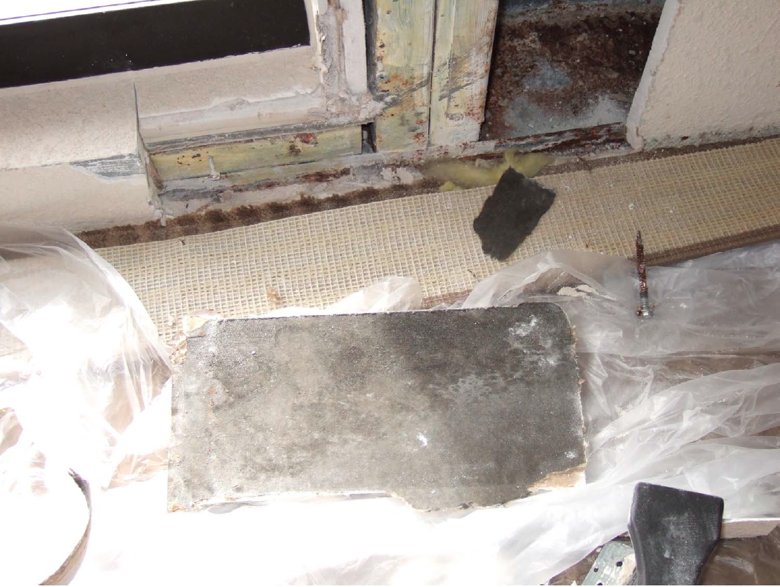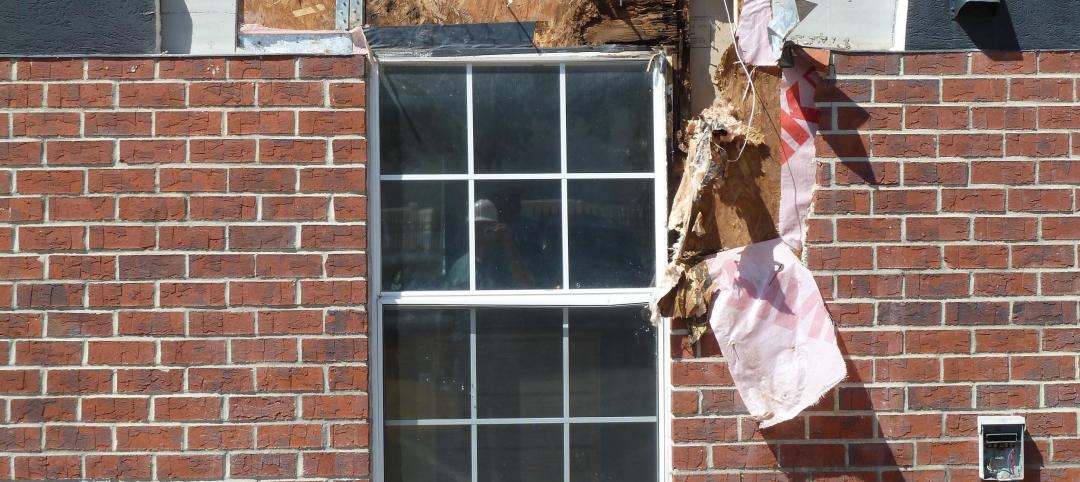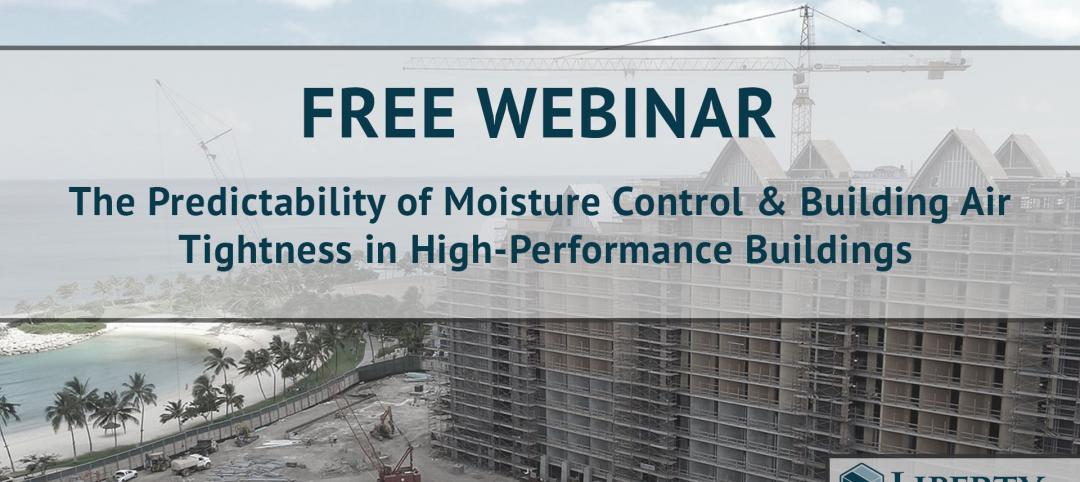Certain faulty beliefs surrounding building performance in warm, humid zones continue to persist in the design and construction industry - and the interaction between building envelopes and HVAC systems is no exception.
Unfortunately, the fact that many architects and engineers rely on such myths as gospel truth during building design has inevitably led to building failures that are often catastrophic in scope.
 This high-rise resort in Central Florida underwent a $9.5M remediation only to have the problem come back the first summer after it was complete.
This high-rise resort in Central Florida underwent a $9.5M remediation only to have the problem come back the first summer after it was complete.
Below is one prevalent myth our experts at Liberty Building Forensics Group (LBFG) have encountered through their extensive work resolving mold and moisture problems in hotels and resorts. The myth is followed by an explanation of why it is false, as well as a first-hand case study supporting this position.
Myth: A building envelope can perform effectively on its own without any help from the HVAC system.
Truth: Put another way, this myth asserts that an architect can design a building envelope in such a way that it is HVAC failure-proof. In actuality, there isn’t a building envelope on earth that an HVAC system can’t damage or destroy in some way.
Hotel guest rooms are unique in that they have a large amount of HVAC per square foot as compared to other building types, like office space. This means that large amounts of air are moved through the volume of a guest room in the forms of ventilation exhaust and supply, and also in the form of actual tempered air conditioning from the guest room unit (e.g., fan coil unit, PTAC, etc.). These large amounts of airflow and cooling or tempered air conditioning can have a significant influence on the temperature gradient across the building envelope and on the condensation potential inside the exterior wall cavity. For these reasons, there is greater risk that the HVAC system, when not designed and installed properly, can result in significant damage to even a well-designed and installed building envelope.
Case Study - Mold and moisture problems in a resort located in a warm, humid climate led to diagnostic tests that prompted the complete remediation of the interior at a cost of $9.5M, only for the same mold problems to return the following summer.
 This picture shows the problem before the first remediation. Similar problems occurred the first summer after the remediation was complete.
This picture shows the problem before the first remediation. Similar problems occurred the first summer after the remediation was complete.
LBFG’s assessment revealed that the original consultants had not accurately evaluated the mold and moisture damage patterns, and as a result, had misdiagnosed – or only partially diagnosed - the root problem.
Our experts have observed that incomplete diagnoses have often been given when buildings experience complex moisture problems that originate with multiple sources. This also frequently happens when a lack of importance is placed on the influence the guest room HVAC system can have on building envelope performance.
In this particular case, one legitimate cause of moisture damage was correctly identified, but others were overlooked. Rainwater leaks were detected, and blame was fully attributed to this factor. However, air infiltration from a defective HVAC system was also a contributing culprit and was missed. As a result, the recommended repairs to the building envelope solved the rainwater leaks but failed to address mechanical system air infiltration and humidity issues, allowing the moisture problems to reoccur.
 When you see this condition, it is because you have a classic air infiltration condensation problem in your wall. The left side is the backside of the DensGlass sheathing, and the right side is the cavity side of the interior drywall. Note the heavy mold impaction on the cavity side of the drywall. This was the condition after the first remediation was complete.
When you see this condition, it is because you have a classic air infiltration condensation problem in your wall. The left side is the backside of the DensGlass sheathing, and the right side is the cavity side of the interior drywall. Note the heavy mold impaction on the cavity side of the drywall. This was the condition after the first remediation was complete.
Complicated moisture problems deserve a multi-disciplinary approach that includes both architectural and mechanical expertise. This is especially important with hotel guest room moisture problems, because the HVAC system can have such a significant influence on the effective air leakage of the exterior wall system, and therefore also have a direct impact on the condensation potential inside that wall.
 The smoke trail shows how infiltration of outdoor air was traveling all the way into the room.
The smoke trail shows how infiltration of outdoor air was traveling all the way into the room.
Conclusion
This building envelope myth warrants careful review and appropriate modifications to standard practice by both architects and engineers. Continued circulation of faulty beliefs throughout the industry reflects a failure to appreciate the full picture when it comes to building design and construction.
The best doctor is one who understands that a specific symptom in the human body is not the root cause of the problem, but rather reflects a deeper issue that is causing a lack of harmony between the various systems of the body. Similarly, the best architects and engineers understand that they do not work in a vacuum or develop their component in a silo, independent of other building system professionals. Buildings are complex. For every one issue that is being addressed, a number of other factors must also be considered in order for the interconnected building systems to be able to perform in an integrated manner.
Click here to read more about this issue.
Download our free e-book on “The Single Most Important Factor in Reducing the Risk of a Mold and Moisture Lawsuit in Your Next Project.”
About the Authors
George DuBose-CGC; Richard Scott, AIA; and Donald B. Snell-PC, Cert. Mech Contractor, CIEC are all building experts at LBFG.
LBFG President George DuBose, with over 25 years’ experience in building failures and a focus on mold and moisture issues as well as HVAC and building envelope failures, is co-author of three manuals on IAQ and Mold Prevention, which have been used on over $4B in construction.
Rick Scott, a Senior Forensic Architect at LBFG with more than 35 years’ architectural experience and an expert in building envelopes, has conducted more than 500 forensic investigations and has helped solve some of the most complicated mold and moisture failures in the world.
Don Snell, a Senior Forensic Engineer/Vice President at LBFG with over 25 years’ experience with all aspects of HVAC systems, has used diagnostic and remedial solutions to help some of the largest commercial builders in the world with catastrophic moisture and mold intrusion resulting from HVAC failure.
LBFG has provided mold and moisture diagnoses and solutions for buildings to owners, contractors, and developers worldwide. The firm has project experience in the U.S., Canada, Mexico, the Caribbean, Central America, the Middle East, Southeast Asia, and Europe. Contact us at g.dubose@libertybuilding.com or by phone at 407/467-5518.
More from Author
George DuBose, CGC; Richard Scott, AIA, NCARB, LEED AP; and Donald B. Snell, PE, Cert. Mech. Contractor, CIEC | Dec 13, 2017
Campus community management firms, beware!
An increasing number of legacy buildings, including aging student housing complexes, are experiencing water intrusion and mold-related damage that can be traced back to fundamental design and construction defects.
George DuBose, CGC; Richard Scott, AIA, NCARB, LEED AP; and Donald B. Snell, PE, Cert. Mech. Contractor, CIEC | Nov 15, 2017
“Till death do us part”: Preventing a facade and HVAC divorce when it comes to air barrier performance
Liberty Building Forensics Group (LBFG) has produced an e-book that speaks directly to the most common air barrier-related factors causing mold and moisture problems in hot and humid climates.








